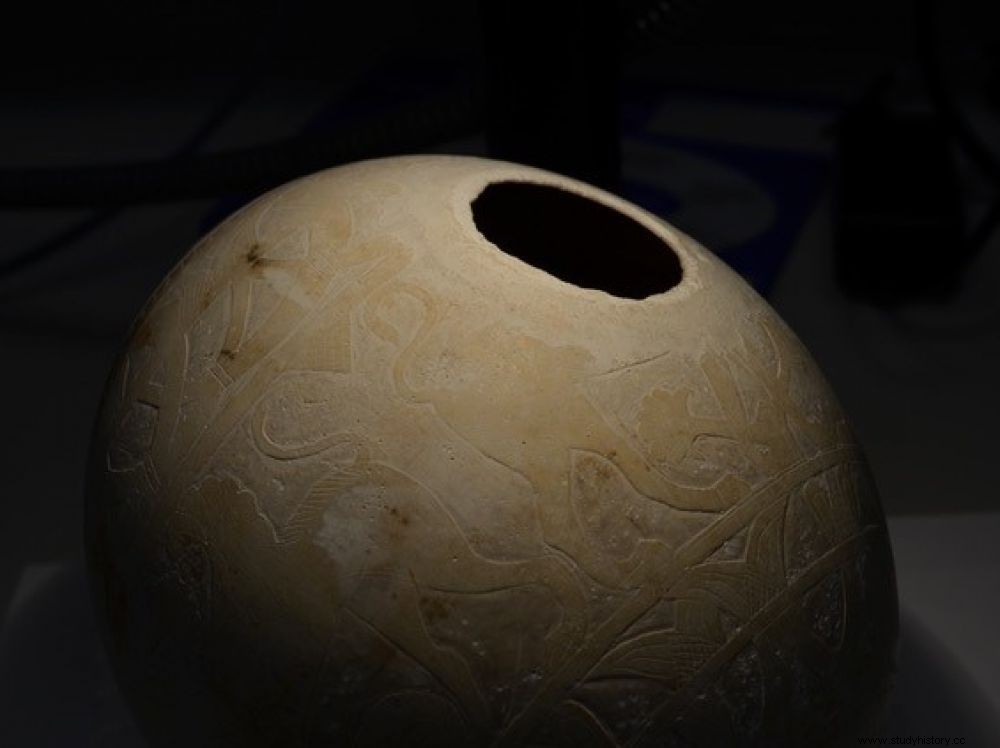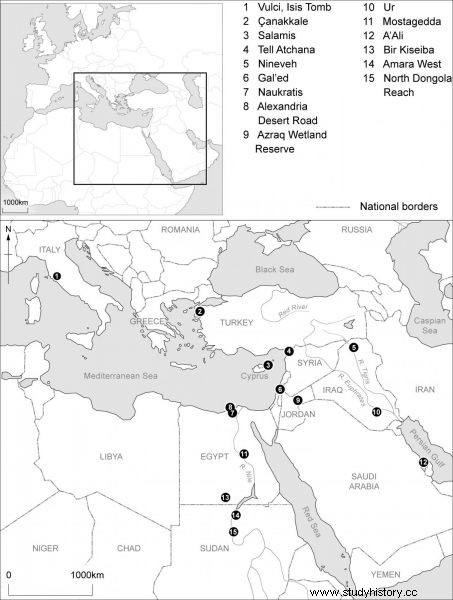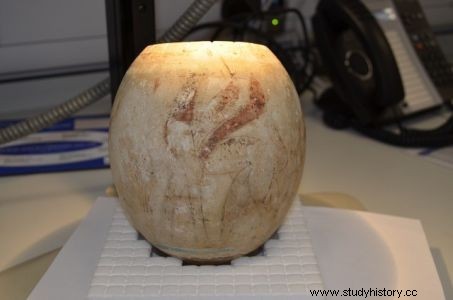Long before Fabergé, ornate ostrich eggs were highly prized by the elites of Mediterranean civilizations. Their production and trade reveal the links of past civilizations.

Decorated ostrich egg from ancient Egypt.
Decorated ostrich eggs are found by the thousands all around the Mediterranean:engraved, painted, adorned with ivory or precious metals such as gold, they were the subject of a vast trade, as articles of luxury during antiquity. "Most of the time they appear in funerary contexts. We don't know if they were used as part of the funeral rituals themselves or if they were intended for the deceased person on their afterlife journey. Their meaning can also vary from culture to culture ", explains Tamar Hodos from the University of Bristol who, together with an international team, has tried to unravel the mystery of the production and trafficking of these eggs.
Native ostriches
3,000 years ago and until the middle of the 20th century, there were ostriches (Struthio camelus syriacus ) in the Middle East and the Eastern Mediterranean, some were even domesticated, but the decorated eggs most likely come from wild ostriches, and the search for an egg could be very risky, as these birds could be extremely dangerous. Tamar Hodos was able to examine five eggs from the collections of the British Museum and from an Etruscan tomb dating from 625 to 550 BC discovered in Vulci, Italy, as well as several others from all over the Mediterranean (see . map below). These shells were probed by scanning electron microscopy in order to determine their chemical and isotopic composition and to study the shaping marks to understand the techniques at work in this very special craft.

Area where decorated ostrich eggs were discovered. Credit:Tamar Hodos/University of Bristol.
The first observations, published in the journal Antiquity , make it possible to distinguish the places of laying of the eggs:the shells contain 95% of calcite (CaCO3), a mineral formed from food and water ingested by the female very shortly before laying.
Decorated ostrich eggs are found by the thousands all around the Mediterranean:engraved, painted, adorned with ivory or precious metals such as gold, they were the subject of a vast trade, as articles of luxury during antiquity. "Most of the time they appear in funerary contexts. We don't know if they were used as part of the funeral rituals themselves or if they were intended for the deceased person on their afterlife journey. Their meaning can also vary from culture to culture ", explains Tamar Hodos from the University of Bristol who, together with an international team, has tried to unravel the mystery of the production and trafficking of these eggs.
Native ostriches
3,000 years ago and until the middle of the 20th century, there were ostriches (Struthio camelus syriacus ) in the Middle East and the Eastern Mediterranean, some were even domesticated, but the decorated eggs most likely come from wild ostriches, and the search for an egg could be very risky, as these birds could be extremely dangerous. Tamar Hodos was able to examine five eggs from the collections of the British Museum and from an Etruscan tomb dating from 625 to 550 BC discovered in Vulci, Italy, as well as several others from all over the Mediterranean (see . map below). These shells were probed by scanning electron microscopy in order to determine their chemical and isotopic composition and to study the shaping marks to understand the techniques at work in this very special craft.

Area where decorated ostrich eggs were discovered. Credit:Tamar Hodos/University of Bristol.
The first observations, published in the journal Antiquity , make it possible to distinguish the egg-laying sites:the shells contain 95% calcite (CaCO3), a mineral formed from food and water ingested by the female very shortly before laying. The analysis of the isotopes contained therefore makes it possible to have an idea of the habitat of the ostrich and therefore of its geographical area of origin. Analyzes reveal that some eggs were transported over long distances, suggesting the presence of extensive trade routes as early as the Bronze Age. In addition, the researchers found that the shells needed to be dried before they could be painted or engraved, which implies storage capacities and therefore a long-term investment for the craftsman or tradesman who takes care of them. . What increase the value of the eggs a little more.
Luxury items
As for the price of a piece, it is difficult to say. "There are no clues that can give us the value of an egg, although we are sure that they were intended and reserved for the elite. We know that unworked eggs were probably also the object of transaction and there were dark shells and light shells depending on the region. It is very likely that in regions where white eggs predominated, black eggs were more expensive ", explains Tamar Hodos. This trade lasted thousands of years, and it is still active today, so it is also almost certain that egg prices have fluctuated over the centuries and according to civilizations and civilizations. the cultures that held them.

Decorated piece from Vulci, Italy. Credit:Tamar Hodos/University of Bristol/British Museum
Other investigations in optical microscopy made it possible to study the techniques and materials used for the ornamentation of the shells. Each represents a glimpse of the craftsmanship of the region and the period of production and it is the whole range of technologies available that has been used for their decoration. In addition to sanding, etching, scraping or abrasion marks, the eggs were also painted and decorated with different elements. Analyzes revealed traces of gold, flint, animal antlers and bark. Which makes them even more valuable.
